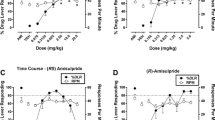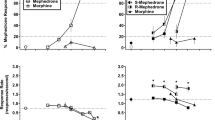Abstract
Rationale
Drug discrimination studies with clozapine have shown that such assays are of value in analysing the actions of novel antipsychotic agents in vivo.
Objectives
To evaluate the role of specific receptors in the discriminative stimulus properties of the novel "atypical" antipsychotic quetiapine.
Methods
Rats were trained to discriminate quetiapine at 10 mg/kg and tested with a range of ligands, selective for specific classes of receptor.
Results
Full generalization to quetiapine was only seen with quetiapine itself (100%) and with the muscarinic antagonist, scopolamine (87%). Partial generalization was seen with the α1-adrenoceptor antagonist prazosin (63%), the presumed preferential dopamine D3 receptor antagonist PNU 91194A (54%) and the 5-HT/H1/M1 antagonist cyproheptadine (55%). Minimal (<40%) or no (0%) generalization was seen with mepyramine (H1 antagonist), SCH 23390 (D1 antagonist), raclopride (D2/3 antagonist), ketanserin and MDL 100,907 (5-HT2A antagonists), ondansetron (5-HT3 antagonist), SB 242,084 (5-HT2C antagonist), 8-OHDPAT (5-HT1A agonist) yohimbine (α2-adrenoceptor antagonist) and the benzodiazepine, chlordiazepoxide.
Conclusions
Together with data from a previous study (Smith and Goudie 2002) in which we observed full generalization to quetiapine with olanzapine, risperidone and clozapine, but not with typical antipsychotics (such as haloperidol) or the novel antipsychotic amisulpride, these data suggest that: i) the discriminative stimulus properties of quetiapine, like those of clozapine, probably reflect a "compound" stimulus which involves several classes of receptor; ii) the quetiapine cue is of value in analysing, and screening for, quetiapine- and clozapine-like agents in vivo; iii) blockade of muscarinic receptors is sufficient, although not necessary, to achieve full generalization to quetiapine; and iv) α1-adrenoceptors may be implicated in the quetiapine discriminative stimulus.
Similar content being viewed by others
References
Arnt J, Skarsfeldt T (1998) Do novel antipsychotics have similar pharmacological characteristics? A review of the evidence. Neuropsychopharmacology 18:63–101
Bakshi VP, Geyer MA (1997) Phencyclidine-induced deficits in prepulse inhibition of startle are blocked by prazosin, an α1 noradrenergic antagonist. J Pharmacol Exp Ther 283:665–674
Bakshi V, Geyer M (1999) Alpha-1-adrenergic receptors mediate sensorimotor gating deficits produced by intracerebral dizocilpine administration in rats. Neuroscience 92:113–121
Borison R, Arvanitis L, Miller B (1996) ICI 204,636, an atypical antipsychotic: efficacy and safety in a multicenter, placebo-controlled trial in patients with schizophrenia. US Seroquel Study Group. J Clin Psychopharmacol 16:158–69
Browne RG, Koe BK (1982) Clozapine and agents with similar behavioral and biochemical properties. In: Colpaert FC, Slangen JL (eds) Drug discrimination: applications in CNS pharmacology. Elsevier, Amsterdam, pp 241–254
Bruhwyler J, Liegeois J, Bergman J, Carey G, Goudie A, Taylor A, Meltzer H, Delarge J, Geczy J (1997) JL13, a pyridobenzoxazepine compound with potential atypical antipsychotic activity: a review of its behavioural properties. Pharmacol Res 36:255–264
Brunello N, Masotto C, Steardo L, Markstein R, Racagni G (1995) New insights into the biology of schizophrenia through the mechanism of action of clozapine. Neuropsychopharmacology 13:177–213
Bymaster FP, Calligaro DO, Falcone JF, Marsh RD, Moore NA, Tye NC, Seeman P, Wong DT (1996) Radioreceptor binding profile of the atypical antipsychotic olanzapine. Neuropsychopharmacology 14:87–96
Carasso BS, Bakshi VP, Geyer MA (1998) Disruption in prepulse inhibition after α1 adrenoceptor stimulation in rats. Neuropharmacology 37:401–404
Carey G, Bergman J (1997) Discriminative-stimulus effects of clozapine in squirrel monkeys: comparison with conventional and novel antipsychotic drugs. Psychopharmacology 132:261–269
Copolov D, Link C, Kowalcyk B (2000) A multicentre, double-blind, randomized comparison of quetiapine (ICI 204,636, "Seroquel") and haloperidol in schizophrenia. Psychol Med 30:95–105
Cussac D, Duqueyroix D, Newman-Tancredi A, Millan M (2002) Stimulation by antipsychotic agents of mitogen-activated protein kinase (MAPK) coupled to cloned, human serotonin (5-HT1A) receptors. Psychopharmacology 162:168–77
Dekeyne A, Girardon S, Millan M (1999) Discriminative stimulus properties of the novel serotonin 5-HT2C receptor agonist, RO 60-0175: a pharmacological analysis. Neuropharmacology 38:415–423
Dekeyne A, Iob L, Hautefaye P, Millan M (2002) The selective serotonin (2A) receptor antagonist, MDL100,907, elicits a specific interoceptive cue in rats. Neuropsychopharmacology 26:552–556
Dekeyne A, Iob L, Millan MJ (2003) Generalization of clozapine as compared to other antipsychotic agents to a discriminative stimulus elicited by the serotonin (5-HT2A) antagonist, MDL100,907. Neuropharmacology 44:604–615
Drouin C, Blanc G, Villégier AS, Glowinski J, Tassin JP (2002) Critical role of α1-adrenergic receptors in acute and sensitized locomotor effects of d-amphetamine, cocaine, and GBR 12783: influence of pre-exposure conditions and pharmacological characteristics. Synapse 43:51–61
Ellenbroek BA, Liegois JK (2003) JL 13, An atypical antipsychotic: a preclinical review. CNS Drug Rev 9:41–56
Extance K, Goudie A (1981) Inter-animal olfactory cues in operant drug discrimination procedures in rats. Psychopharmacology 73:363–371
Franklin S, Tang A (1994) Discriminative stimulus effects of clozapine in rats. Behav Pharmacol 5:113
Gleason S, Lucaites V, Shannon H, Neslon D, Leander J (2001) m-CPP hypolocomotion is selectively antagonised by compounds with high affinity for 5-HT2C receptors but not 5-HT2A or 5-HT2B receptors. Behav Pharmacol 12:613–620
Gobert A, Di Cara B, Cistarlli L, Millan MJ (2003) Piribedil enhances frontocortical release of acetylcholine in freely-moving rats by blockade of alpha2-adrenoceptors: a dialysis comparison to other antiparkinson agents in the absence of acetylcholinesterase inhibitors. J Pharmacol Exp Ther (in press)
Goldstein J (1999) Quetiapine fumarate (Seroquel): a new atypical antipsychotic. Drugs Today 35:193–210
Goudie AJ, Leathley MJ (1993) Drug discrimination assays. In: Sahgal A (ed) Behavioural neuroscience. Oxford University Press, Oxford, pp 145–167
Goudie A, Smith J (1999) Discriminative stimulus properties of antipsychotics. Pharmacol Biochem Behav 64:193–201
Goudie A, Taylor A (1998) Comparative characterisation of the discriminative stimulus properties of clozapine and other antipsychotics in rats. Psychopharmacology 135:392–400
Goudie A, Smith J, Taylor A, Taylor M, Tricklebank M (1998) Discriminative stimulus properties of the atypical neuroleptic clozapine in rats: tests with subtype selective receptor ligands. Behav Pharmacol 9:699–710
Goudie A, Baker L, Smith J, Prus A, Svensson K, Cortes-Burgos L, Wong E, Haadsma-Svensson S (2001) Common discriminative stimulus properties in rats of muscarinic antagonists, clozapine and the D3 preferring antagonist PNU 99194A: an analysis of possible mechanisms. Behav Pharmacol 12:303–315
Harkin A, Morris K, Kelly JP, O'Donnell JM, Leonard BE (2001) Modulation of MK-801-induced behaviour by noradrenergic agents in mice. Psychopharmacology 154:177–188
Hoenicke EM, Vanecek SA, Woods JH (1992) The discriminative stimulus effects of clozapine in pigeons: involvement of 5-hydroxytryptamine1C and 5-hydroxytryptamine2 receptors. J Pharmacol Exp Ther 263:276–284
Ichikawa J, Dai J, O'Laughlin IA, Fowler WL, Meltzer HY (2002a) Atypical, but not typical, antipsychotic drugs increase cortical acetylcholine release without an effect in the nucleus accumbens or striatum. Neuropsychopharmacology 26:325–339
Ichikawa J, Li Z, Dai J, Meltzer H (2002b) Atypical antipsychotic drugs quetiapine, iloperidone, and melperone, preferentially increase dopamine and acetylcholine release in rat medial prefrontal cortex: role of 5-HT1A receptor agonism. Brain Res 956:369–377
Kapur S, Remington G (2001) Atypical antipsychotics: new directions and new challenges in the treatment of schizophrenia. Annu Rev Med 52:503–517
Kasper S, Muller-Spahn F (2000) Review of quetiapine and its clinical applications in schizophrenia. Exp Opin Pharmacother 1:783–801
Kasper S, Tauscher J, Heiden A (2001) Quetiapine: efficacy and tolerability in schizophrenia. Eur Neuropsychopharmacol 11:S405–413
Kelley B, Porter J (1997) The role of muscarinic cholinergic receptors in the discriminative stimulus properties of clozapine in rats. Pharmacol Biochem Behav 57:707–719
Mariathasan EA, Stolerman IP, White JA (1999) Influence of training paradigm on specificity of drug mixture discriminations. Pharmacol Biochem Behav 64:409–413
Migler B, Warawa E, Malick J (1993) Seroquel: behavioral effects in conventional and novel tests for atypical antipsychotic drug. Psychopharmacology 112:299–307
Millan M, Schreiber R, Monneyron S, Denorme B, Melon C, Queriaux S, Dekeyne A (1999) S-16924, a novel, potential antipsychotic with marked serotonin1A agonist properties. IV. A drug discrimination comparison with clozapine. J Pharmacol Exp Ther 289:427–436
Millan M, Brocco M, Rivet J, Audinot V, Newman-Tancredi A, Maiofiss L, Queriaux S, Despaux N, Peglion J, Dekeyne A (2000) S18327 (1-[2-[4-(6-fluoro-1, 2-benzisoxazol-3-yl)piperid-1-yl]ethyl]3-phenyl imidazolin-2-one), a novel, potential antipsychotic displaying marked antagonist properties at alpha(1)- and alpha(2)-adrenergic receptors: II. Functional profile and a multiparametric comparison with haloperidol, clozapine, and 11 other antipsychotic agents. J Pharmacol Exp Ther 292:54–66
Newman-Tancredi A, Verriele L, Touzard M, Millan M (2001) Efficacy of antipsychotic agents at human 5-HT(1A) receptors determined by [3H]WAY100,635 binding affinity ratios: relationship to efficacy for G-protein activation. Eur J Pharmacol 428:177–184
Nielsen EB (1988) Cholinergic mediation of the discriminative stimulus properties of clozapine. Psychopharmacology 94:115–118
Porter J, Villaneuva H, Rosecrans J (1999) Role of D1 and D2 receptors in the discriminative stimulus properties of the atypical antipsychotic clozapine in rats. Drug Dev Res 46:139–147
Porter J, McCallum S, Varvel S, Vann R (2000a) The discriminative stimulus properties of the atypical antipsychotic olanzapine in rats. Psychopharmacology 148:224–233
Porter J, Varvel S, Vann R, Philibin S, Wise L (2000b) Clozapine discrimination with a low training dose distinguishes atypical from typical antipsychotic drugs in rats. Psychopharmacology 149:189–193
Saller C, Salama A (1993) Seroquel: biochemical profile of a potential atypical antipsychotic. Psychopharmacology 112:285–292
Schreiber R, Brocco M, Millan M (1994) Blockade of the discriminative stimulus effects of DOI by MDL 100,907 and the "atypical" antipsychotics, clozapine and risperidone. Eur J Pharmacol 264:99–102
Smith J, Goudie A (2002) Discriminative properties in rats of the novel antipsychotic quetiapine. Exp Clin Psychopharmacol 10:376–384
Stolerman IP, Mariathasan EA, Garcha HS (1991) Discriminative stimulus effects of drug mixtures in rats. In: Glennon RA, Jarbe TUC, Frankenheim J (eds) Drug discrimination: applications to drug abuse research. NIDA Monograph 116, US Government Printing Office, Washington D.C., pp 277–306
Swerdlow N, Zisook D, Taaid N (1994) Seroquel (ICI 204,636) restores prepulse inhibition of acoustic startle in apomorphine-treated rats: similarities to clozapine. Psychopharmacology 114:675–678
Swerdlow N, Bakshi V, Geyer M (1996) Seroquel restores sensorimotor gating in phencyclidine-treated rats. J Pharmacol Exp Ther 279:1290–1299
Tang A, Franklin S, Himes C, Smith M, Tenbrink R (1997) PNU 96415E, a potential antipsychotic agent with clozapine-like pharmacological properties. J Pharmacol Exp Ther 281:440–447
Tarsy D, Baldessarini R, Tarazi F (2002) Effects of newer antipsychotics on extrapyramidal function. CNS Drugs 16:23–45
Velligan D, Newcomer J, Pultz J, Csernansky J, Hoff A, Mahurin R, Miller A (2002) Does cognitive function improve with quetiapine in comparison to haloperidol? Schizophr Res 53:239–248
Wiley JL, Porter JH (1992) Serotonergic drugs do not substitute for clozapine in clozapine-trained rats in a two-lever drug discrimination procedure. Pharmacol Biochem Behav 43:961–965
Zhang M, van de Stolpe A, Zuiderveld O, Timmerman H (1997) Synthesis and pharmacological evaluation of some amino acid containing cyproheptadine derivatives as dual antagonists of H1 and leukotriene D4 receptors. Eur J Med Chem 32:95–102
Zhang, W, Basile, AS, Gomeza, J, Volpicelli, J, Volpicelli, LA, Levey AI and Wess J (2002) Characterization of central inhibitory muscarinic autoreceptors by the use of muscarinic acetylcholine receptor knock-out mice, J Neurosci 22:1709–1717
Acknowledgements
Dr. J.A. Smith was supported by funds from the UK Medical Research Council. We are greatly indebted to Ms. Juliet McAdams for expert technical assistance.
Author information
Authors and Affiliations
Corresponding author
Rights and permissions
About this article
Cite this article
Goudie, A.J., Smith, J.A. & Millan, M.J. Characterization of the effects of receptor-selective ligands in rats discriminating the novel antipsychotic quetiapine. Psychopharmacology 171, 212–222 (2004). https://doi.org/10.1007/s00213-003-1576-x
Received:
Accepted:
Published:
Issue Date:
DOI: https://doi.org/10.1007/s00213-003-1576-x




